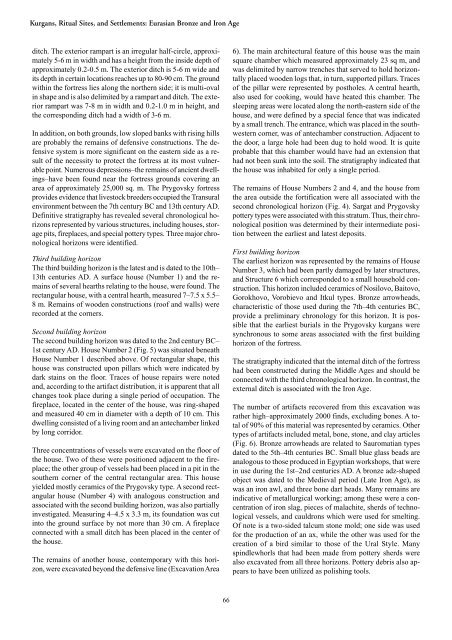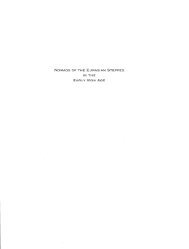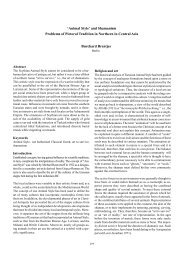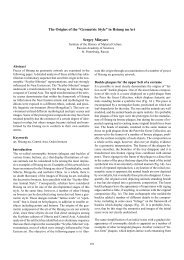Part II Archaeological Excavations - Center for the Study of Eurasian ...
Part II Archaeological Excavations - Center for the Study of Eurasian ...
Part II Archaeological Excavations - Center for the Study of Eurasian ...
Create successful ePaper yourself
Turn your PDF publications into a flip-book with our unique Google optimized e-Paper software.
Kurgans, Ritual Sites, and Settlements: <strong>Eurasian</strong> Bronze and Iron Age<br />
ditch. The exterior rampart is an irregular half-circle, approximately<br />
5-6 m in width and has a height from <strong>the</strong> inside depth <strong>of</strong><br />
approximately 0.2-0.5 m. The exterior ditch is 5-6 m wide and<br />
its depth in certain locations reaches up to 80-90 cm. The ground<br />
within <strong>the</strong> <strong>for</strong>tress lies along <strong>the</strong> nor<strong>the</strong>rn side; it is multi-oval<br />
in shape and is also delimited by a rampart and ditch. The exterior<br />
rampart was 7-8 m in width and 0.2-1.0 m in height, and<br />
<strong>the</strong> corresponding ditch had a width <strong>of</strong> 3-6 m.<br />
In addition, on both grounds, low sloped banks with rising hills<br />
are probably <strong>the</strong> remains <strong>of</strong> defensive constructions. The defensive<br />
system is more significant on <strong>the</strong> eastern side as a result<br />
<strong>of</strong> <strong>the</strong> necessity to protect <strong>the</strong> <strong>for</strong>tress at its most vulnerable<br />
point. Numerous depressions–<strong>the</strong> remains <strong>of</strong> ancient dwellings–have<br />
been found near <strong>the</strong> <strong>for</strong>tress grounds covering an<br />
area <strong>of</strong> approximately 25,000 sq. m. The Prygovsky <strong>for</strong>tress<br />
provides evidence that livestock breeders occupied <strong>the</strong> Transural<br />
environment between <strong>the</strong> 7th century BC and 13th century AD.<br />
Definitive stratigraphy has revealed several chronological horizons<br />
represented by various structures, including houses, storage<br />
pits, fireplaces, and special pottery types. Three major chronological<br />
horizons were identified.<br />
Third building horizon<br />
The third building horizon is <strong>the</strong> latest and is dated to <strong>the</strong> 10th–<br />
13th centuries AD. A surface house (Number 1) and <strong>the</strong> remains<br />
<strong>of</strong> several hearths relating to <strong>the</strong> house, were found. The<br />
rectangular house, with a central hearth, measured 7–7.5 x 5.5–<br />
8 m. Remains <strong>of</strong> wooden constructions (ro<strong>of</strong> and walls) were<br />
recorded at <strong>the</strong> corners.<br />
Second building horizon<br />
The second building horizon was dated to <strong>the</strong> 2nd century BC–<br />
1st century AD. House Number 2 (Fig. 5) was situated beneath<br />
House Number 1 described above. Of rectangular shape, this<br />
house was constructed upon pillars which were indicated by<br />
dark stains on <strong>the</strong> floor. Traces <strong>of</strong> house repairs were noted<br />
and, according to <strong>the</strong> artifact distribution, it is apparent that all<br />
changes took place during a single period <strong>of</strong> occupation. The<br />
fireplace, located in <strong>the</strong> center <strong>of</strong> <strong>the</strong> house, was ring-shaped<br />
and measured 40 cm in diameter with a depth <strong>of</strong> 10 cm. This<br />
dwelling consisted <strong>of</strong> a living room and an antechamber linked<br />
by long corridor.<br />
Three concentrations <strong>of</strong> vessels were excavated on <strong>the</strong> floor <strong>of</strong><br />
<strong>the</strong> house. Two <strong>of</strong> <strong>the</strong>se were positioned adjacent to <strong>the</strong> fireplace;<br />
<strong>the</strong> o<strong>the</strong>r group <strong>of</strong> vessels had been placed in a pit in <strong>the</strong><br />
sou<strong>the</strong>rn corner <strong>of</strong> <strong>the</strong> central rectangular area. This house<br />
yielded mostly ceramics <strong>of</strong> <strong>the</strong> Prygovsky type. A second rectangular<br />
house (Number 4) with analogous construction and<br />
associated with <strong>the</strong> second building horizon, was also partially<br />
investigated. Measuring 4–4.5 x 3.3 m, its foundation was cut<br />
into <strong>the</strong> ground surface by not more than 30 cm. A fireplace<br />
connected with a small ditch has been placed in <strong>the</strong> center <strong>of</strong><br />
<strong>the</strong> house.<br />
The remains <strong>of</strong> ano<strong>the</strong>r house, contemporary with this horizon,<br />
were excavated beyond <strong>the</strong> defensive line (Excavation Area<br />
66<br />
6). The main architectural feature <strong>of</strong> this house was <strong>the</strong> main<br />
square chamber which measured approximately 23 sq m, and<br />
was delimited by narrow trenches that served to hold horizontally<br />
placed wooden logs that, in turn, supported pillars. Traces<br />
<strong>of</strong> <strong>the</strong> pillar were represented by postholes. A central hearth,<br />
also used <strong>for</strong> cooking, would have heated this chamber. The<br />
sleeping areas were located along <strong>the</strong> north-eastern side <strong>of</strong> <strong>the</strong><br />
house, and were defined by a special fence that was indicated<br />
by a small trench. The entrance, which was placed in <strong>the</strong> southwestern<br />
corner, was <strong>of</strong> antechamber construction. Adjacent to<br />
<strong>the</strong> door, a large hole had been dug to hold wood. It is quite<br />
probable that this chamber would have had an extension that<br />
had not been sunk into <strong>the</strong> soil. The stratigraphy indicated that<br />
<strong>the</strong> house was inhabited <strong>for</strong> only a single period.<br />
The remains <strong>of</strong> House Numbers 2 and 4, and <strong>the</strong> house from<br />
<strong>the</strong> area outside <strong>the</strong> <strong>for</strong>tification were all associated with <strong>the</strong><br />
second chronological horizon (Fig. 4). Sargat and Prygovsky<br />
pottery types were associated with this stratum. Thus, <strong>the</strong>ir chronological<br />
position was determined by <strong>the</strong>ir intermediate position<br />
between <strong>the</strong> earliest and latest deposits.<br />
First building horizon<br />
The earliest horizon was represented by <strong>the</strong> remains <strong>of</strong> House<br />
Number 3, which had been partly damaged by later structures,<br />
and Structure 6 which corresponded to a small household construction.<br />
This horizon included ceramics <strong>of</strong> Nosilovo, Baitovo,<br />
Gorokhovo, Vorobievo and Itkul types. Bronze arrowheads,<br />
characteristic <strong>of</strong> those used during <strong>the</strong> 7th–4th centuries BC,<br />
provide a preliminary chronology <strong>for</strong> this horizon. It is possible<br />
that <strong>the</strong> earliest burials in <strong>the</strong> Prygovsky kurgans were<br />
synchronous to some areas associated with <strong>the</strong> first building<br />
horizon <strong>of</strong> <strong>the</strong> <strong>for</strong>tress.<br />
The stratigraphy indicated that <strong>the</strong> internal ditch <strong>of</strong> <strong>the</strong> <strong>for</strong>tress<br />
had been constructed during <strong>the</strong> Middle Ages and should be<br />
connected with <strong>the</strong> third chronological horizon. In contrast, <strong>the</strong><br />
external ditch is associated with <strong>the</strong> Iron Age.<br />
The number <strong>of</strong> artifacts recovered from this excavation was<br />
ra<strong>the</strong>r high–approximately 2000 finds, excluding bones. A total<br />
<strong>of</strong> 90% <strong>of</strong> this material was represented by ceramics. O<strong>the</strong>r<br />
types <strong>of</strong> artifacts included metal, bone, stone, and clay articles<br />
(Fig. 6). Bronze arrowheads are related to Sauromatian types<br />
dated to <strong>the</strong> 5th–4th centuries BC. Small blue glass beads are<br />
analogous to those produced in Egyptian workshops, that were<br />
in use during <strong>the</strong> 1st–2nd centuries AD. A bronze adz-shaped<br />
object was dated to <strong>the</strong> Medieval period (Late Iron Age), as<br />
was an iron awl, and three bone dart heads. Many remains are<br />
indicative <strong>of</strong> metallurgical working; among <strong>the</strong>se were a concentration<br />
<strong>of</strong> iron slag, pieces <strong>of</strong> malachite, sherds <strong>of</strong> technological<br />
vessels, and cauldrons which were used <strong>for</strong> smelting.<br />
Of note is a two-sided talcum stone mold; one side was used<br />
<strong>for</strong> <strong>the</strong> production <strong>of</strong> an ax, while <strong>the</strong> o<strong>the</strong>r was used <strong>for</strong> <strong>the</strong><br />
creation <strong>of</strong> a bird similar to those <strong>of</strong> <strong>the</strong> Ural Style. Many<br />
spindlewhorls that had been made from pottery sherds were<br />
also excavated from all three horizons. Pottery debris also appears<br />
to have been utilized as polishing tools.





